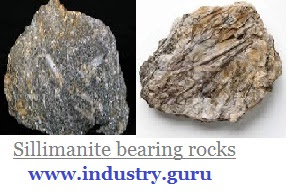Sillimanite as a natural and untreated mineral is a very important raw material for high alumina refractories which are extensively used in Iron and steel, Petrochemical, Electrical, Cement, Zinc and Glass industries.

Due to the very low expansion or contraction on heating, sillimanite need not be calcined before use. Unlike sillimanite from most of the sources in the World which are used as it is, the Rewa sillimanite (found in Madhya Pradesh, India), because of its impurities, should not be used as such. It is always better once to wash these lumps in the raw material yard itself and then after shifting to the Mill House and crushing, grinding pass through magnetic separator to eliminate the free iron impurities.
The ideal firing temperature of green refractory bricks made of sillimanite grains as a major raw material is 1450 - 1500OC, to be fired either in a batch type or a tunnel kiln. The soaking time will vary depending upon the volume, shape, setting and other constituents of the bricks (particularly raw clay used and sintering aid, if any).
Sillimanite Refractories
Sillimanite refractories are characterized of high refractoriness, very low coefficient of thermal expansion, high refractoriness under load (RUL) and mechanical strength with great resistance to thermal shock (spalling resistance), abrasion and slag corrosion. Due to their exceptionally high resistance to spalling and corrosive actions of molten glass, chemical attacks of soda, borax and other frits, they are most suitable for Glass Melting Furnace (GMT), Oil fired Furnace, Cement Rotary Kiln, Blast Furnace, Electric Arc Furnace (EAF) roofs, Hot Metal Mixer, Combustion Chambers and Metallurgical operations done in Zinc Furnace, Gold Refining Furnace etc.

Particularly in Glass industry sillimanite refractories have got many applications, such as in glass melting tank furnaces (to be discussed in detail in a separate article) in all parts open to the products of combustion like combustion chambers, flues, door pillars which may have to support heavy load at high temperatures, recuperators and such other parts which are liable to be subjected to fluctuations of temperature. Assam Sillimanite once available in good quality and quantity, even for export, were used to be cut into blocks of various sizes from solid rock at the site of deposits itself which were then sent to the user’s site for their direct use in construction of Glass Melting tank Furnace bottom. But now it is a forgotten past! However, there are quite a few suppliers in India who manufacture these GT blocks, mostly using certain percentage of sillimanite sand or even sillimanite lumps after crushing and grinding. To name a few are Maithan Ceramics Limited (MCL), Tata Refractories Limited (TRL), OCL India Limited, ORIND (quality ?) etc. So far the properties like density (BD), porosity, mechanical strength, slag corrosion resistance and consistency of performance etc. are concerned, high capacity machine pressed bricks are far too superior to those made by pneumatic ramming. Although it is a general practice to give some ‘patching/finishing’ manually before inspection - dispatch to particularly big and complicated shape refractory bricks but from the customers’ point of view it is most important that during inspection it must be ensured that except for the ‘look’ only, the refractory brick (or block) does not depend much on the ‘finishing’, if at all, done on it. Patching is a wrong practice as it is done to camouflage the flaws which could be detected by seeing the brick.
For GT blocks the machine finish of the surface is very important. It must be evenly polished or ground to ensure that the warpage is negligible. One of the main criteria for acceptance of these blocks should be that in the assembly there should not be any open joint (the specification could be from 0.2mm - 0.3mm filler gauge up to a maximum 20 - 25mm depth from the top). This is a must to avoid the penetration and subsequent crystallization of glass and alkali vapours in these joints. To meet this criterion the manufacturer should have facilities for grinding of these blocks minimum in 4 faces and in some bricks up to 6 faces and then marked accordingly.








0 on: "Use of Sillimanite as Raw Material in Refractories"